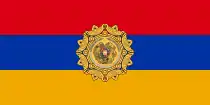Levon Ter-Petrosyan
Levon Hakobi Ter-Petrosyan[lower-alpha 1] (Armenian: Լևոն Հակոբի Տեր-Պետրոսյան; born 9 January 1945), also known by his initials LTP, is an Armenian politician. He was the first President of Armenia from 1991 to 1998. A senior researcher at the Matenadaran Institute of Ancient Manuscripts, he led the Karabakh movement for the unification of the Armenian-populated Nagorno-Karabakh with Armenia in 1988. After Armenia's independence from the Soviet Union in 1991, Ter-Petrosyan was elected president in October 1991 with overwhelming public support. He led the country through the First Nagorno-Karabakh War with neighboring Azerbaijan, during which Armenia supported the Republic of Artsakh in fighting against Azerbaijan.
Levon Ter Petrosyan | |
|---|---|
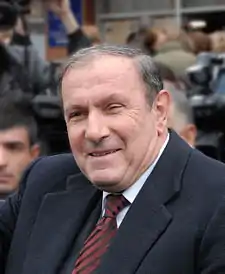 | |
| 1st President of Armenia | |
| In office 11 November 1991 – 3 February 1998 | |
| Vice President | Gagik Harutyunyan |
| Preceded by | position established |
| Succeeded by | Robert Kocharyan |
| Chairman of the Supreme Council | |
| In office 4 August 1990 – 11 November 1991 | |
| Preceded by | position established |
| Succeeded by | Babken Ararktsyan |
| Personal details | |
| Born | Levon Hakobi Ter-Petrosyan 9 January 1945 Aleppo, Syria |
| Nationality | Armenian |
| Political party | Pan-Armenian National Movement (1989–2008) Armenian National Congress (2008–) |
| Other political affiliations | Pan-Armenian National Movement (2008–2013) |
| Spouse(s) | Lyudmila Ter-Petrosyan (née Pleskovskaya) |
| Children | David Ter-Petrosyan |
| Alma mater | Yerevan State University Leningrad State University |
| Signature | |
| Website | www |
He has been accused of rigging the 1996 election, causing thousands to go into the streets to protest the results. The protesters were led by official runner-up Vazgen Manukyan, Ter-Petrosyan's former colleague and his first Prime Minister and later the Defence Minister. The mass rallies were suppressed by military force. Due to disagreements with the key government members over a peace proposal for the Nagorno-Karabakh conflict, especially Defence Minister Vazgen Sargsyan and Prime Minister Robert Kocharyan, Ter-Petrosyan resigned on 3 February 1998.[1]
From his resignation up to 2007, Ter-Petrosyan was inactive in the political scene, however, he made a political comeback in September 2007 and ran for presidency in 2008. He faced one of his former government members, at the time Prime Minister Serzh Sargsyan. According to official results, he earned 21.5% of the total vote. Ter-Petrosyan claimed the elections were rigged and led thousands of his supporters into mass protests against the alleged electoral fraud and called for new elections. After a week of mass protests, the government used police and military force to disperse his supporters, resulting in the death of ten people on 1 March 2008.
On 1 August 2008, Ter-Petrosyan founded the Armenian National Congress (ANC) which included more than a dozen of political parties and NGOs. Being the main opposition party in Armenia, the ANC was out of the parliament and was mainly involved in street struggle against Serzh Sargsyan's government. They organized mass rallies in 2011, forcing the government to grant several political concessions. In parliamentary elections in 2012, the ANC received 7.1% of the popular vote, gaining 7 seats. Ter-Petrosyan's party lost those seats in the following elections and has not entered parliament since.
Early life and education
Ter-Petrosyan was born on 9 January 1945 in Aleppo, Syria to an Armenian family descended from a long line of priests living near Musa Dagh in the region of Cilicia (now located in the south of Turkey).[2] His family took part in the Musa Dagh Resistance during the Armenian Genocide before fleeing to Syria.[2] His father, Hakob Ter-Petrosyan, was first a member of the Hunchakian Party[2] and later a founding member of the Syrian Communist Party.[3](p57) His family emigrated to Soviet Armenia in 1946.[4] In 1968, he graduated from the Oriental Studies Department of Yerevan State University. In 1972, he completed his postgraduate studies at Leningrad State University. In 1987, he received his doctoral degree from the same university. From 1972 to 1978, Ter-Petrosyan worked as junior researcher at the Manouk Abeghian Literature Institute of the Armenian Academy of Sciences.[2] From 1978 to 1985, he held the post of science secretary at Matenadaran named after Saint Mesrob Mashdots. Since 1985, he has worked at Matenadaran as a senior researcher.[4]
Scientific career
Ter-Petrosyan is fluent in 12 languages: Armenian, Russian, French, English, German, Arabic, Turkish, Assyrian,[5] and several extinct languages (Aramaic, ancient Greek, Latin, ancient Hebrew). He is the author of more than 30 books, about 80 scientific articles in Armenian, Russian and French and thousands of political publications in the multilingual press (speeches, articles, interviews, press conferences, etc.).[2] He is a member of the Writers Union of Armenia, the French Asian Society, the Mekhitarist Academy in Venice and a recipient of honorary doctorates from the University of La Verne, University of Sofia, Paris-Sorbonne University and University of Strasbourg.[2]
Karabakh movement and independence of Armenia
In late 1987 and early 1988, the Karabakh movement emerged in Soviet Armenia and the Armenian-majority Nagorno-Karabakh Autonomous Oblast with the goal of transferring the autonomous region from Azerbaijan to Armenia. On 19 May 1988, Levon Ter-Petrosyan, Vazgen Manukyan and 9 others founded a new Karabakh Committee, which soon took leadership of the Karabakh movement from the older Committee led by Zori Balayan and Igor Muradyan.[6] Levon Ter-Petrosyan was the de facto leader of the committee.[6] Under the leadership of Ter-Petrosyan and Manukyan, the Karabakh movement transformed from being purely concerned with the unification of Nagorno-Karabakh with Armenia into a broader movement for democratization.[6]
From 10 December 1988 to 31 May 1989, Ter-Petrosyan was imprisoned in Moscow's Matrosskaya Tishina prison together with other members of the Karabakh Committee; they returned to Yerevan after their release and continued their activities.[4] In 1989, Ter-Petrosyan and the other members of the Karabakh Committee founded a political party called the Pan-Armenian National Movement (ANM, also known by its Armenian acronym HHSh). Later on, Ter-Petrosyan became the party's chairman.[4] On 27 August 1989, he was elected as a deputy of the Supreme Soviet of the Armenian SSR, and reelected on 20 May 1990.[4] In elections in May 1990, the Pan-Armenian National Movement won a majority of seats in the Supreme Soviet of Armenia, becoming the first non-communist party to take power in a Soviet republic.[3](p111) On 4 August of the same year, Ter-Petrosyan was elected Chairman of the Supreme Council of Armenia, becoming the de facto leader of Armenia.[7]
As clashes between newly formed Armenian militias and Soviet forces intensified in mid-1990, Ter-Petrosyan was pressured by Soviet leader Mikhail Gorbachev to disarm the militias. Ter-Petrosyan complied, but the militias continued their activities in Nagorno-Karabakh.[8] On 23 August 1990, Armenia formally declared its intention to become an independent state with Nagorno-Karabakh as an integral part.[8] On 12 Septemeber 1990, Ter-Petrosyan met with Gorbachev, Azerbaijani leader Ayaz Mutalibov and other Soviet officials, where Gorbachev rejected Ter-Petrosyan's demands to withdraw the Soviet Army from Armenian settlements and create a line of demarcation between Armenians and Azebaijanis in Nagorno-Karabakh.[8] Although Ter-Petrosyan initially expressed his willingness to include Armenia in a new union of sovereign states to replace the USSR, he found Mikhail Gorbachev's proposal for a new union treaty unacceptable. Armenia was one of six Soviet republics not to participate in the referendum on the new union held in March 1991.[8]
As Armenia moved toward independence, further clashes occurred both within Armenia and on the border with Azerbaijan in May 1991, and Soviet troops undertook an operation to deport Armenian villagers from parts of Azerbaijan.[8] Ter-Petrosyan publicly stated on 6 May 1991 that "To all intents and purposes, the Soviet Union has declared war on Armenia."[8] Ter-Petrosyan opposed the coup attempt against Gorbachev in August 1991. He attended unsuccessful negotiations with Ayaz Mutalibov mediated by Boris Yeltsin and Nursultan Nazarbayev in late September.[8] On 20 September 1991, Armenians voted overwhelmingly in favor of independence, and the country officially declared independence three days later.[8]
Presidency: 1991–1998
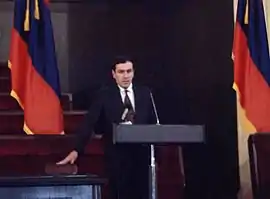
First term
Ter-Petrosyan was elected the first President of the newly independent Republic of Armenia on 16 October 1991, receiving 83% of the vote. On 18 October 1991, he signed onto Gorbachev's failed attempt to form an economic community out of the collapsing Soviet Union and preserve the economic ties between the republics (only 8 of the 15 republics agreed to sign). Ter-Petrosyan then brought Armenia into the Commonwealth of Independent States which formed after the formal abolition of the Soviet Union in December 1991.[8] In late 1991 and early 1992, the fighting in Nagorno-Karabakh expanded into a full-scale war. After major Armenian losses in the summer of 1992, Ter-Petrosyan dismissed Defense Minister Vazgen Sargsyan and appointed his comrade-turned-rival Vazgen Manukyan to the post.[3](p210) The regular Armenian Army was formed during this time, and the tide of the war turned decisively in Armenia's favor. Armenian forces secured not only most of the territory of the former Nagorno-Karabakh Autonomous Oblast but also captured seven districts of Azerbaijan surrounding the core territory. Although Armenian authorities officially stated that the Republic of Armenia was not a participant in the war and only provided support to Nagorno-Karabakh Armenian forces, in reality Karabakh Armenian forces and the Armenian Army were united in their military actions.[3](p210) According to Defense Minister Manukyan, on several occasions the more cautious Ter-Petrosyan was deliberately not fully informed about the extent of the Armenian military's participation in operations in Nagorno-Karabakh.[3](p210) The war ended in an Armenian victory with the signing of a ceasefire agreeement in May 1994 by representatives of Armenia, Azerbaijan and the Nagorno-Karabakh Republic.
Despite Ter-Petrosyan's efforts to establish normal relations with Turkey (Azerbaijan's supporter in the war), which included arranging for the transport of wheat to Armenia from the EU through Turkish territory and attending the funeral of Turkish president Turgut Özal in Ankara, the capture of Kalbajar district by Armenian forces in April 1993 significantly worsened relations with Turkey. That month Turkey closed its border with Armenia.[3](p213) As on other occasions, Ter-Petrosyan only been presented a small part of the Kalbajar operation by Vazgen Manukyan.[3](p212) The Turkish-Armenian border remains closed to this day and the two countries have no diplomatic relations.
Armenia suffered severe economic hardship in the first years following independence, as it had been deeply integrated with the Soviet economy and had the highest level of imports of any Soviet republic.[8] Its main route to Russia through Azerbaijan was cut off and the route through Georgia was frequently closed due to civil unrest there.[3](p205) Armenia's GDP declined drastically from 1991 to 1993 because of these factors, and fuel shortages were ubiquitous․[9] The worst years of the energy crisis have been dubbed the "dark and cold years" in Armenia, alleviated only by the restarting of Metsamor Nuclear Power Plant in October 1995. In 1992, Ter-Petrosyan's prime minister Hrant Bagratyan adopted an economic reform program to rapidly marketize the Armenian economy, which was followed by mass deindustrialization and inflation.[9] From 1991 to 1993, Armenia experienced the largest decline in industrial output out of any of the post-Soviet states, and the majority of economic activity occurred in the unregulated shadow economy.[9] The mass privatization of the economy was accompanied by the growth of corruption. By the end of Ter-Petrosyan's presidency in February 1998, about 1,350 medium and large enterprises had been privatized, largely concentrated in the hands of a small part of the population.[9] Armenia's economic hardships during Ter-Petrosyan's presidency made him deeply unpopular among much of the population, and some 800,000 people emigrated from Armenia during his presidency.[9]
Ter-Petrosyan's first term also saw significant tension between his government and the Armenian Revolutionary Federation (ARF), a nationalist political party which holds enormous influence in the Armenian diaspora and had established itself as Ter-Petrosyan's main opposition. On 29 June 1992, Ter-Petrosyan delivered a televised address where he accused the ARF of collaboration with the KGB and pilfering funds raised from the diaspora intended for Armenia and Nagorno-Karabakh. Two years later, on 28 December 1994, Ter-Petrosyan declared that a plot by the ARF to violently overthrow the government had been uncovered. The party was banned from the Republic of Armenia and its offices were raided by police.[10] Thirty-one ARF members, who would later be known as the "Dro Group", an alleged secret wing of the ARF, were arrested and charged with conspiracy to overthrow the government, committing a number of assassinations and drug trafficking; all were found guilty.[9] The ban on the ARF was lifted by Ter-Petrosyan's successor Robert Kocharyan soon after Ter-Petrosyan's resignation.[9]
1996 reelection
Although Ter-Petrosyan was initially expected to win the 1996 presidential election by a large margin due to the opposition being divided, three other candidates dropped out of the race and endorsed Vazgen Manukyan.[11] According to the official results, Ter-Petrosyan received about 52%, just above the 50% required to win without a runoff election.[11] His reelection was marred by allegations of electoral fraud reported by the opposition and supported by many international observers. On 25 September 1996, around 200,000 people in Yerevan came out to protest the election results, then stormed the parliament building and beat the speaker and deputy speaker of parliament following a speech by Vazgen Manukyan.[11] Tanks and troops were brought into Yerevan to end the protests. On the same day, Defence Minister Vazgen Sargsyan stated that "even if they [the opposition] win 100 percent of the votes, neither the Army nor the National Security and Interior Ministry would recognize such political leaders."[3](p258) Ter-Petrosyan's popularity waned further as the opposition started blaming him for the economic quagmire that Armenia's post-Soviet economy was in.
Resignation
Ter-Petrosyan was forced to step down in February 1998 after advocating a compromised settlement of the conflict over Nagorno-Karabakh which many Armenians regarded as undermining their security. Ter-Petrosyan's key ministers, namely then-Prime Minister Robert Kocharyan, Defense Minister Vazgen Sargsyan and Interior Minister Serzh Sargsyan, refused to accept a peace plan for Karabakh put forward by international mediators in September 1997.[12] The leadership of the Nagorno-Karabakh Republic were also opposed to the plan. The plan, accepted by Ter-Petrosyan and Azerbaijan's leader Heydar Aliyev, called for a "phased" settlement of the conflict which would postpone an agreement on Karabakh's status, the main stumbling block. The "phased" approach envisioned the return of most of the Armenian-occupied Azerbaijani territories around Nagorno-Karabakh in exchange for the deployment of OSCE peacekeepers in Nagorno-Karabakh and the surrounding districts in the first and second phases, followed by the lifting of the Azerbaijani and Turkish blockades of Armenia in the third stage, and leaving for last the issues of Nagorno-Karabakh's status, the Lachin Corridor, and the return of displaced persons.[12] When Levon Ter-Petrosyan stepped down from the presidency, he compared himself to the late Israeli Prime Minister Yitzhak Rabin, and stated that he was resigning was to avoid destabilizing the country.[13]
Comeback
After his resignation, Ter-Petrosyan rarely appeared in public and avoided contact with the media, although there were speculations that he would run for the office of president of Armenia in the general election in February 2003. He instead devoted his time to scientific research. In 2005 and 2007, he published his two-volume historical work titled The Crusaders and the Armenians.[2]
2008 election
On 21 September 2007, Ter-Petrosyan made his first public speech in nearly ten years at an event in Yerevan marking the 16th anniversary of Armenia's declaration of independence. In this speech he was strongly critical of President Kocharyan. Subsequently, Ter-Petrosyan officially announced his candidacy in the 2008 presidential election in a speech in Yerevan on 26 October 2007. He accused Kocharyan's government of massive corruption, involving the theft of "at least three to four billion dollars" over the previous five years. He was critical of the government's claims of strong economic growth and argued that Kocharyan and his prime minister, Serzh Sargsyan, had come to accept a solution to the problem of Nagorno-Karabakh that was effectively the same solution that he had proposed ten years earlier. A number of opposition parties have rallied behind him since his return to the political arena, including the People's Party of Armenia led by Stepan Demirchyan, the Republic Party led by Aram Sargsyan,[14] the Social Democrat Hunchakian Party, "Azadakrum" movement for Jirair Sefilian, "New Times" Party and Raffi Hovannisian's Heritage Party.[15]
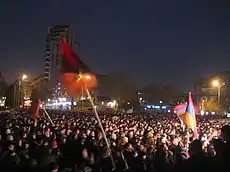
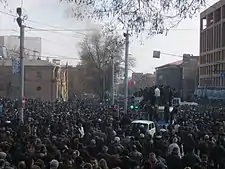
Protests
Final results from the election, which was held on 19 February 2008, officially showed Ter-Petrosyan in second place with 21.5% of the vote. Then he and his supporters accused the government of rigging the election and claimed victory;[16] beginning on 20 February he led continuous protests involving tens of thousands of his supporters in Yerevan.[17]
In the early morning hours of 1 March, reportedly acting on evidence of firearms in the camp, the authorities moved in to inspect the tents set up by demonstrators. Law enforcement agents then violently dispersed the hundreds of protestors camped in. Ter-Petrosyan was placed under de facto house arrest, not being allowed to leave his home, though the authorities later denied the allegations.[18] A few hours later, tens of thousands of protestors or more gathered at Myasnikyan Square to protest the government's act. Police, overwhelmed by the sheer size of the crowd, pulled out. A state of emergency was implemented by President Kocharyan at 17:00, allowing the army to be moved into the capital. At night, a few thousand protestors barricaded themselves using commandeered municipal buses. As a result of the clashes, eight protestors and two policemen died.[19] Ter-Petrosyan addressed his supporters by phone at around 2-3 a.m. on March 2, telling them to go home to avoid further casualties.[20] On March 5, Ter-Petrosyan appealed to the Constitutional Court to have the election declared invalid, which was rejected.[20]
Armenian National Congress
In 2011, Ter-Petrosyan again took a leading role in protests that erupted in Armenia as part of a wave of regional unrest.[21] As leader of the Armenian National Congress opposition bloc, formed two years prior to the outbreak of protests, Ter-Petrosyan accused President Serzh Sargsyan, elected in the disputed 2008 election, of being "illegitimate" and called for the release of political prisoners, the resignation of the government, and a full inquiry into the violence that claimed the lives of ten people on 1 March 2008.[22][23]
2009 Yerevan election
2012 parliamentary election
Levon Ter-Petrosyan led the Armenian National Congress (ANC) during the 2012 parliamentary election. The ANC won 7.08% (106,903) of the popular vote.[24]
2013 presidential election
The ANC held its convention on 22 December 2012. Ter-Petrosyan talked about groups promoting pro-Western and pro-Russian divisions within the Armenian society and the political parties calling them "dangerous forces". Ter-Petrosyan did not announce whether he will run for president in February 2013.[25] Few days after the convention on 25 December 2012, Ter-Petrosyan gave Chorrord Inknishkhanutyun an interview eventually declaring his decision not to run for the office. He claimed that "dozens of arguments are being put forward by those advocating and opposing my nomination, but the most important argument has been avoided. Can anyone who has respect for his people vie for a presidential post at the age of 68? Such things usually do not happen in developed democratic countries ... everything is concentrated in the hands of a bunch of criminals who have usurped power."[26]
The official ANC statement on 27 December 2012 said that they are not participating in the upcoming presidential election in any form. The ANC claimed that the participation in the election is "legitimization of the illegal regime."[27] Rumors about Ter-Petrosyan's possible retirement from active politics spread soon after his 25 December announcement. Armenians newspapers argued that Levon Zurabyan, the ANC speaker, could become his successor.[28]
On 7 February 2013, Ter-Petrosyan gave another interview to the Chorrord Inknishkhanutyun daily newspaper. He acknowledged that the ANC cannot continue its activities with the same structure. He admitted that the alliance had "internal fermentations"[29] and called "various political forces and non-partisan individuals of the Congress to merge into one single political party."[30]
The presidential election was held on 18 February 2013. Voting in a polling station in central Yerevan, Ter-Petrosyan said the journalists he voted for the "sake of the Republic of Armenia."[31] According to the official results, incumbent Serzh Sargsyan won with over 58% of the vote. Raffi Hovannisian, the main opposition candidate who earned 37% of the total, claimed victory and started mass protests the next day. On 23 February 2013, Ter-Petrosyan addressed the gathered at the Pan-Armenian National Movement party convention. He claimed Hovannisian won the election and accused incumbent Sargsyan in rigging the election. Talking about Hovannisian's post-election protests, Ter-Petrosyan stated "I see words, I see speeches, but there is no action, no plan of actions."[32]
On 13 April 2013, the Armenian National Congress was officially transformed from an alliance of 18 original parties into a single party, on the base of the Pan-Armenian National Movement. During his speech at the founding convention, Ter-Petrosyan blamed Hovannisian for having no political agenda in his protests. In particular, Ter-Petrosyan said "during the current post-election period we have seen everything but political processes."[33]
2013 Yerevan election
The ANC, now a party rather than an alliance, went to the 2013 Yerevan City Council election alone. Their list was headed by Yerevan's former mayor Vahagn Khachatryan.[34] ANC failed to pass the 6% threshold by gaining only 1.2℅.
2020 Nagorno-Karabakh war
During the 2020 Nagorno-Karabakh war, Ter-Petrosyan met with fellow ex-presidents of Armenia Robert Kocharyan and Serzh Sargsyan as well as ex-presidents of the Nagorno-Karabakh Republic Arkadi Ghukasyan and Bako Sahakyan to discuss the situation.[35] In October 2020, Kocharyan and Ter-Petrosyan requested that Prime Minister Nikol Pashinyan give them permission to go to Moscow as special negotiators.[36] Pashinyan accepted their request to go to Moscow to meet with Russian officials, but not as official negotiators. The visit never occurred as Kocharyan tested positive for COVID-19.[36]
After the defeat of the Armenian side in the war, the signing of the 2020 Nagorno-Karabakh ceasefire agreement and the outbreak of protests in Armenia against Prime Minister Nikol Pashinyan, Ter-Petrosyan released a statement where he warned of the risk of a destructive civil war and called for the solution of the political crisis by constitutional means only.[37] He called for the prime minister's voluntary resignation and accused him and the opposition candidate Vazgen Manukyan of leading the country to civil confrontation through their refusal to compromise.[37]
Personal life
He is married to Lyudmila (née Pleskovskaya); the couple has one son, David, who is an economist and businessman, and three grandchildren (Levon, Hakob, Lusia).[2]
Publications
- Ter Petrosian, Levon (1992). Ancient Armenian Translations. New York: Krikor and Clara Zohrab Information Center/St. Vartan Press.[38]
- Ter-Petrosyan, Levon (2005). Խաչակիրները և հայերը: Հ. Ա. Ուսումնասիրություն և թարգմանություններ [The Crusaders and the Armenians: Volume I: Research and translations] (in Armenian). Yerevan.[39]
- Ter-Petrosyan, Levon (2007). Խաչակիրները և հայերը: Հ. Բ. Պատմա-քաղաքագիտական հետազոտություն [The Crusaders and the Armenians: Volume II: Historical-political analysis] (in Armenian). Yerevan: Calouste Gulbenkian Foundation.[40]
Notes
- Also transliterated as Ter-Petrossian and Ter-Petrosian
References
- Astourian, Stephan H. (2001). From Ter-Petrosian to Kocharian: Leadership Change in Armenia (PDF). University of California, Berkeley. Archived from the original (PDF) on 20 June 2013. Retrieved 11 January 2013.
- "Լեւոն Տեր-Պետրոսյանի լրացված կենսագրությունը" [Levon Ter-Petrosyan's completed biography]. ilur.am. I Lur. 13 March 2015. Archived from the original on 31 January 2021. Retrieved 31 January 2021.
- De Waal, Thomas (2003). Black Garden: Armenia and Azerbaijan through Peace and War. New York and London: New York University Press. ISBN 0-8147-1944-9.
- "Levon Ter-Petrosyan". president.am. Official website of the President of the Republic of Armenia. Retrieved 29 January 2021.
- Hakobyan, Tatul (27 March 2009). "Armenia is a homeland for the Assyrians, who have no homeland". The Armenian Reporter. Archived from the original on 30 May 2013. Retrieved 22 June 2013.
- Geukjian, Ohannes (2011). Ethnicity, Nationalism and Conflict in the South Caucasus: Nagorno-Karabakh and the Legacy of Soviet Nationalities Policy. Farnham: Ashgate. p. 154. ISBN 9781409436300.
- "The Official Levon Ter-Petrosian for President Web Site". Archived from the original on 2016-12-17. Retrieved 2012-05-02.
- Suny, Ronald Grigor (1993). "Armenia on the Road to Independence, Again". Looking Towards Ararat: Armenia in Modern History. Bloomington and Indianapolis: Indiana University Press. pp. 231–246. ISBN 0-253-35583-4.
- Astourian, Stephan H. (2001). From Ter-Petrosian to Kocharian: Leadership Change in Armenia (PDF). University of California, Berkeley. Archived from the original (PDF) on 20 June 2013. Retrieved 11 January 2013.CS1 maint: ref=harv (link)
- "ARF newspaper banned". Archived from the original on 6 December 2006. Retrieved 2006-12-27.
- "Armenian Presidential election" (PDF). Commission on Security and Cooperation in Europe. 1997. Retrieved 27 January 2021.
- Geukjian, Ohannes (2014). Negotiating Armenian-Azerbaijani Peace: Opportunities, Obstacles, Prospects. Farnham: Ashgate. pp. 94–96. ISBN 978-1-4724-3515-6.
- Bransten, Jeremy (9 February 1998). "Armenia: President's Resignation Leads To Political Crisis". Radio Free Europe/Radio Liberty. Prague. Retrieved 1 February 2021.
- Emil Danielian and Liz Fuller, "Armenian Ex-President Confirms Comeback Plans", Radio Free Europe/Radio Liberty, 1 November 2007.
- Payqar newspaper
- "Armenian opposition candidate accuses prime minister of election violations", Associated Press (International Herald Tribune), 19 February 2008.
- "Thousands challenge victory of Armenian PM in presidential vote in 2nd day of protests", Associated Press (International Herald Tribune), 21 February 2008.
- "Ter-Petrosian ‘Under House Arrest’, Rally Broken Up", Radio Liberty Archived 2008-11-23 at the Wayback Machine
- "Armenia: Eight Killed After Clashes Between Police, Protesters", Radio Free Europe/Radio Liberty, 2 March 2008.
- "Democracy on Rocky Ground". hrw.org. Human Rights Watch. 25 February 2009. Retrieved 1 February 2021.
- "Armenia protests gather pace". Menas Associates. 18 March 2011. Retrieved 26 April 2011.
- "Ter-Petrosian Sets New Deadline For Armenian Leadership". Massis Post. 8 April 2011. Retrieved 26 April 2011.
- "Armenian Opposition Threatens 'War' If Political Prisoners Not Freed". Radio Free Europe/Radio Liberty. 14 April 2011. Retrieved 26 April 2011.
- Danielyan, Emil (11 May 2012). "Armenian President Wins Big in Parliamentary Elections; Eurasia Daily Monitor Volume: 9 Issue: 90". Jamestown Foundation. Retrieved 7 October 2013.
- "Friends and Foes: Ter-Petrosyan speech seen as unlikely overtures to Kocharyan". ArmeniaNow. 24 December 2012. Retrieved 9 May 2013.
- "Vote 2013: Ter-Petrosyan rules out presidential bid over his age". ArmeniaNow. 25 December 2012. Retrieved 9 May 2013.
- "Vote 2013: Opposition bloc refuses to take part in presidential race". ArmeniaNow. 27 December 2012. Retrieved 9 May 2013.
- "ANC into a party?: Paper says opposition bloc set to undergo transformation". ArmeniaNow. 29 January 2013. Retrieved 9 May 2013.
- "Ter-Petrosyan acknowledges dissent within opposition bloc; says ANC to turn into political party". ArmeniaNow. 7 February 2013. Retrieved 9 May 2013.
- "Political End or New Beginning?: Ter-Petrosyan plans for reformatting opposition bloc draw mixed reactions". ArmeniaNow. 8 February 2013. Retrieved 9 May 2013.
- "Decision 2013: Armenian first president said all seven candidates are worthy". ArmeniaNow. February 18, 2013. Retrieved 9 May 2013.
- "Ter-Petrosyan acknowledges Hovannisian's election 'victory', says oppositionist still lacks plan of action". ArmeniaNow. 25 February 2013. Retrieved 9 May 2013.
- "Ter-Petrosyan sees no 'political process' in Hovannisian's campaign, dismisses accusations". ArmeniaNow. 13 April 2013. Retrieved 9 May 2013.
- "Yerevan Vote 2013: Ter-Petrosyan party to contest municipal elections on its own". ArmeniaNow. 15 March 2013. Retrieved 9 May 2013.
- "Former Armenian Presidents Meet to Discuss Artsakh". Asbarez. Yerevan. 21 October 2020. Retrieved 29 January 2021.
- Harutyunyan, Sargis (30 November 2020). "Վարչապետը մանրամասներ է հրապարակել Տեր-Պետրոսյանի և Քոչարյանի Մոսկվա չմեկնելու վերաբերյալ" [The prime minister has published details about Ter-Petrosyan and Kocharyan not going to Moscow]. Azatutyun. Retrieved 29 January 2021.
- "Levon Ter-Petrosyan Says Armenia Faces Threat of Civil War". hetq.am. 6 December 2020. Retrieved 29 January 2021.
- review of the book
- review of the book in Armenian
- review of the book in Armenian
| Political offices | ||
|---|---|---|
| New office | Chairperson of the Supreme Council of Armenia 1990–1991 |
Position abolished |
| President of Armenia 1991–1998 |
Succeeded by Robert Kocharyan | |
